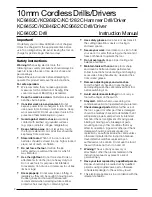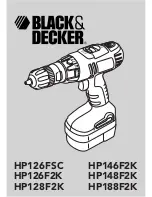
420 774 335 397 www.sharks-shop.cz Stránka 41
OPERATION
1. Commissioning
A) Inserting and removing the battery
Insert the charged Li-Ion battery into the bottom of the saw handle. Make sure the polarity is
correct, and do not use force when inserting the battery! The process of inserting and
removing the battery should be smooth and resistive. Insert the battery into the underside
until the locking clips on the sides secure the battery (you will hear a spring snap, a click).
On the other hand, removing the battery will give you a light finger pressure on the battery
release button and by moving the battery itself from the drill body.
B) Charge the battery
Always charge the battery fully. Do not exceed charging time.
When charging a new battery, the battery should be fully discharged, followed by a full
battery charge. The first charge should be 60 m 30 minutes and the other the same.
By doing so, the battery will be adjusted and its voltage will be balanced. This ensures
optimal battery operation. Another charge is already 60 minutes.
If you are using a rechargeable battery (rechargeable battery), always allow the charger to
cool before recharging another battery. The recommended charging time for the charger is
30-45 minutes.
Attention! Overcharging the battery or recharging a partially discharged battery can lead to a
rapid increase in battery temperature and internal pressure. Damage or explosion of the
battery may occur.
This can happen even if the battery is overwhelmed and used. It is therefore important that
the battery is completely discharged before charging and that the charging time is not
exceeded. Recharging partially discharged batteries can cause battery failure.
The battery in normal storage at room temperature can lose about 5% of its charge within a
few months, a common phenomenon for all lithium batteries. Upon storage at higher
temperatures,% is increased.
CHARGING THE BATTERY
The battery charger is for internal use only. We do not recommend charging in your home. It
is recommended to charge it in a workshop or garage. Charging must be carried out in a
ventilated room, and must not be near flammable materials. Never exceed the charging time
to avoid damage to the charger or battery.
BATTERY LIQUIDATION
If the battery is already damaged, dispose of it properly. Do not dispose of the battery with
household waste but dispose of it in a collection yard or other designated location, or contact
your local authority.
SPECIAL SAFETY INSTRUCTIONS
If the battery is not properly charged or improperly handled, it may be damaged. Follow the
following precautions when handling batteries. Before removing or installing the battery, be
sure to turn off the device.
Do not expose the battery to open flame or excessive heat.
Do not immerse the battery in water or expose it to moisture and rain.
Do not store or allow contact with loose metal objects.









































